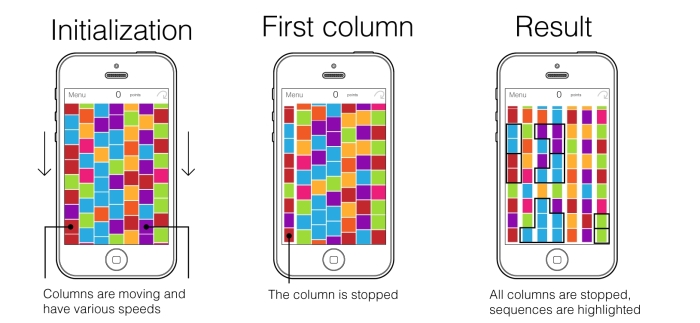Well, there are columns in the game that can move if pushed by the player's finger; without any external impact, they stand still. Let's turn it topsy-turvy. After that, the columns always move down. Being infinite lines, they have various speeds, so a stream of tiles is not regular. A player can stop any of them by touching them. How can such a bizarre concept be turned into a real game experience? Everything is simple: the player should apply the brakes to each column at the right time so they assemble a tile sequence. An automatic align procedure can be developed. It looks like slot machine mechanics, but it is not based on fortuity alone; the player can see the flow of tiles and choose the right moment to tap the screen by himself. We call this mode Moving columns.
As soon as all columns are stopped, the roll call function is called, and after that the game operates like an ordinary match-three puzzle: sequence outlining, point counting, element eliminating, and so on. The following screenshot shows the Moving columns mode with coherent control:

Undoubtedly, the control mechanism is pretty important in this case. If there was talk about a system without multitouch, coherent control could be used: the player touches columns one by one, and each click means that a column is stopped until the matching process is finished or the player presses it again and unchecks it. It is pretty simple and reliable. The game process can be made more complex by introducing a timer to pause the column. In other words, once the player has pressed and stopped one line of tiles, he should hurry to apply the brakes to other lines or the timers for the first ones will run out of time and the columns will begin to move again. The timer can be expressed as a semitransparent scrollbar that covers a pressed column. One of the advantages of coherent control, based on single touches, is the possibility to work with wide game boards, that is, 6, 8, or 10 tiles in a row.
Nevertheless, this type of input is a bit sluggish, is not very exciting, and does not feature vast support to multi-touch paradigm. Let's try to make something more funny, may be even crazy. What do you think about pushing the player to use more than one finger to control the game, activating his dexterity and body coordination to the maximum? We could do something like putting only four tiles in a row. The columns move, and the player must stop them simultaneously by using four fingers at once as if he is playing a small piano keyboard. I think that four fingers is an optimal number; the player uses all fingers except the thumb, which is not nimble enough in this situation. Now imagine how funny the game process is; the tiles are falling down, the player has to notice possible combinations and react fast, controlling each column. But this is not easy, especially when the pinky finger must be used to apply the brakes to the fourth column. There are a lot of mistakes made, but they can be recovered from very quickly because the game constantly generates new content. So, gameplay is dynamic, funny, and addictive. A possible tagline for this mode is Catch the sequence.

But of course, the game needs more attention towards balance to work well; for example, the number of tile types should reduce to four or five, as more number of tile types increases the probability of long combinations. The speed must be pretty low at the very beginning of a game session, increasing over time as the game is played.
Because of the dynamic and unpredictable nature of this game mode, the puzzle cannot be stopped naturally by removing all the tiles from the array as they are constantly regenerated. So, other types of signals to end the current game should be used: timers (the players gets specific time segments to play) or challenges to collect a determined number of points (for instance, 1,000, 5,000, and 10,000).
